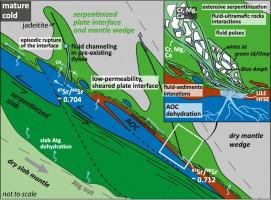Tracking fluid sources in mantle wedge jadeitites: Petro-geochemical constraints and implications for fluid venting above the subduction interface
IF 3.6
2区 地球科学
Q1 GEOCHEMISTRY & GEOPHYSICS
引用次数: 0
Abstract
Jadeitites are commonly found in serpentinite mélanges and form by fluid flow across the subduction interface. Petrological analysis of jadeitites from various localities (Myanmar, Guatemala, Cuba, Russia, and Iran) coupled with structural characterization enabled the identification of successive jadeite/omphacite generations with subordinate amphibole and mica. These parageneses reflect metasomatism coeval with brittle and/or ductile deformation and complex crosscutting relationships. The composition of fluid inclusions (salinity, gas, δ18O, δD) reveals a wide range of fluid species pointing to a diversity of jadeitite-forming metasomatism. In situ trace element analysis and isotopic measurements (δ11B, 87Sr/86Sr, δ18O) indicate a fluid source dominated by altered oceanic crust (AOC) with a minor sedimentary component. Despite marked changes in major element content during protracted metasomatism, trace elements evolve only moderately while isotopes are virtually homogeneous, recording only small variations of fluid composition over time. Jadeitite evolution is strongly related to the ongoing serpentinization of the mantle wedge, promoting a longer fluid time-residence at the interface associated with chemical exchange and pore-pressure build-up. This suggests that (i) First jadeite generations formed by percolation of highly channelized AOC-derived-fluids in a dry mantle wedge, while later generations record fluid interaction with sediments and the serpentinized mantle. (ii) Fluid pulses across the subduction interface and rheological behavior of the near interface mantle wedge are not controlled by drastic changes in the nature of the slab input, but rather by the cooling of the serpentinizing subduction environment. (iii) The re-use of the same fluid pathways above the slab promotes the re-equilibration of isotopic signatures. (iv) Overpressures may build up upon jadeitite formation and promote brittle deformation events. This may lead to switches in deformation style and variations in permeability, thus changing fluid flow mode along the base of the mantle wedge.

追踪地幔楔型翡翠岩的流体来源:俯冲界面以上流体喷发的石油地球化学限制及其意义
硬玉岩常见于蛇纹岩中,由流体流过俯冲界面形成。对不同地区(缅甸、危地马拉、古巴、俄罗斯和伊朗)的翡翠岩进行了岩石学分析,并结合结构特征,确定了翡翠/辉长石的连续世代,其属角闪石和云母。这些共生关系反映了与脆性和/或韧性变形同时发生的交代作用和复杂的横切关系。流体包裹体的组成(盐度、气体、δ18O、δD)显示了广泛的流体种类,表明形成硬玉的交代作用具有多样性。原位微量元素分析和同位素测量(δ11B、87Sr/86Sr、δ18O)表明流体源以蚀变洋壳(AOC)为主,沉积成分较少。尽管在长期的交代作用中,主要元素的含量发生了显著的变化,但微量元素的演变只是适度的,而同位素几乎是均匀的,随着时间的推移,只记录了流体成分的微小变化。硬玉岩的演化与地幔楔的蛇纹石化密切相关,促使流体在界面停留的时间更长,这与化学交换和孔隙压力的积累有关。这表明:(1)第一代硬玉是由高度通道化的aoc衍生流体在干燥的地幔楔体中渗透形成的,而后几代则记录了流体与沉积物和蛇纹岩化地幔的相互作用。(ii)跨俯冲界面的流体脉冲和近界面地幔楔的流变行为不是由板块输入性质的剧烈变化所控制,而是由蛇纹石化俯冲环境的冷却所控制。(三)重新使用石板上方相同的流体通道,促进了同位素特征的重新平衡。(iv)超压可能在硬玉形成过程中积聚,并促进脆性变形事件。这可能导致变形方式的转换和渗透率的变化,从而改变流体沿地幔楔基底的流动方式。
本文章由计算机程序翻译,如有差异,请以英文原文为准。
求助全文
约1分钟内获得全文
求助全文
来源期刊

Chemical Geology
地学-地球化学与地球物理
CiteScore
7.20
自引率
10.30%
发文量
374
审稿时长
3.6 months
期刊介绍:
Chemical Geology is an international journal that publishes original research papers on isotopic and elemental geochemistry, geochronology and cosmochemistry.
The Journal focuses on chemical processes in igneous, metamorphic, and sedimentary petrology, low- and high-temperature aqueous solutions, biogeochemistry, the environment and cosmochemistry.
Papers that are field, experimentally, or computationally based are appropriate if they are of broad international interest. The Journal generally does not publish papers that are primarily of regional or local interest, or which are primarily focused on remediation and applied geochemistry.
The Journal also welcomes innovative papers dealing with significant analytical advances that are of wide interest in the community and extend significantly beyond the scope of what would be included in the methods section of a standard research paper.
 求助内容:
求助内容: 应助结果提醒方式:
应助结果提醒方式:


